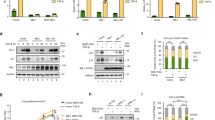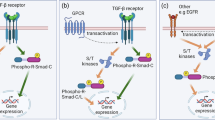Abstract
Transforming growth factor-β (TGF-β) potently inhibits cell cycle progression at the G1 phase1,2. Smad3 has a key function in mediating the TGF-β growth-inhibitory response. Here we show that Smad3 is a major physiological substrate of the G1 cyclin-dependent kinases CDK4 and CDK2. Except for the retinoblastoma protein family3,4, Smad3 is the only CDK4 substrate demonstrated so far. We have mapped CDK4 and CDK2 phosphorylation sites to Thr 8, Thr 178 and Ser 212 in Smad3. Mutation of the CDK phosphorylation sites increases Smad3 transcriptional activity, leading to higher expression of the CDK inhibitor p15. Mutation of the CDK phosphorylation sites of Smad3 also increases its ability to downregulate the expression of c-myc. Using Smad3-/- mouse embryonic fibroblasts and other epithelial cell lines, we further show that Smad3 inhibits cell cycle progression from G1 to S phase and that mutation of the CDK phosphorylation sites in Smad3 increases this ability. Taken together, these findings indicate that CDK phosphorylation of Smad3 inhibits its transcriptional activity and antiproliferative function. Because cancer cells often contain high levels of CDK activity5,6, diminishing Smad3 activity by CDK phosphorylation may contribute to tumorigenesis and TGF-β resistance in cancers.
This is a preview of subscription content, access via your institution
Access options
Subscribe to this journal
Receive 51 print issues and online access
$199.00 per year
only $3.90 per issue
Buy this article
- Purchase on SpringerLink
- Instant access to full article PDF
Prices may be subject to local taxes which are calculated during checkout




Similar content being viewed by others
References
Massagué, J., Blain, S. W. & Lo, R. S. TGF-β signaling in growth control, cancer, and heritable disorders. Cell 103, 295–309 (2000)
Derynck, R., Akhurst, R. J. & Balmain, A. TGF-β signaling in tumor suppression and cancer progression. Nature Genet. 29, 117–129 (2001)
Weinberg, R. A. The retinoblastoma protein and cell cycle control. Cell 81, 323–330 (1995)
Sherr, C. J. & Roberts, J. M. CDK inhibitors: positive and negative regulators of G1-phase progression. Genes Dev. 13, 1501–1512 (1999)
Hall, M. & Peters, G. Genetic alterations of cyclins, cyclin-dependent kinases, and Cdk inhibitors in human cancer. Adv. Cancer Res. 68, 67–108 (1996)
Sherr, C. J. Cancer cell cycles. Science 274, 1672–1677 (1996)
Hannon, G. J. & Beach, D. p15INK4B is a potential effector of TGF-β-induced cell cycle arrest. Nature 371, 257–261 (1994)
Li, J. M., Nichols, M. A., Chandrasekharan, S., Xiong, Y. & Wang, X.-F. Transforming growth factor β activates the promoter of cyclin-dependent kinase inhibitor p15INK4B through an Sp1 consensus site. J. Biol. Chem. 270, 26750–26753 (1995)
Moustakas, A. & Kardassis, D. Regulation of the human p21/WAF1/Cip1 promoter in hepatic cells by functional interaction between Sp1 and Smad family members. Proc. Natl Acad. Sci. USA 95, 6733–6738 (1998)
Pardali, K. et al. Role of Smad proteins and transcription factor Sp1 in p21Waf1/Cip1 regulation by transforming growth factor-β. J. Biol. Chem. 275, 29244–29256 (2000)
Feng, X.-H., Lin, X. & Derynck, R. Smad2, Smad3 and Smad4 cooperate with Sp1 to induce p15Ink4B transcription in response to TGF-β. EMBO J. 19, 5178–5193 (2000)
Seoane, J., Le, H. V., Shen, L., Anderson, S. A. & Massague, J. Integration of Smad and forkhead pathways in the control of neuroepithelial and glioblastoma cell proliferation. Cell 117, 211–223 (2004)
Chen, C. R., Kang, Y. & Massagué, J. Defective repression of c-myc in breast cancer cells: A loss at the core of the transforming growth factor growth arrest program. Proc. Natl Acad. Sci. USA 98, 992–999 (2001)
Yagi, K. et al. c-myc is a downstream target of the Smad pathway. J. Biol. Chem. 277, 854–861 (2002)
Chen, C.-R., Kang, Y., Siegel, P. M. & Massagué, J. E2F4/5 and p107 as Smad cofactors linking the TGF-β receptor to c-myc repression. Cell 110, 19–32 (2002)
Frederick, J. P., Liberati, N. T., Waddell, D. S., Shi, Y. & Wang, X. F. Transforming growth factor beta-mediated transcriptional repression of c-myc is dependent on direct binding of Smad3 to a novel repressive Smad binding element. Mol. Cell. Biol. 24, 2546–2559 (2004)
Zhu, Y., Richardson, J. A., Parada, L. F. & Graff, J. M. Smad3 mutant mice develop metastatic colorectal cancer. Cell 94, 703–714 (1998)
Han, S. U. et al. Loss of the Smad3 expression increases susceptibility to tumorigenicity in human gastric cancer. Oncogene 23, 1333–1341 (2004)
Ashcroft, G. S. et al. Mice lacking Smad3 show accelerated wound healing and an impaired local inflammatory response. Nature Cell Biol. 1, 260–266 (1999)
Yang, X. et al. Targeted disruption of SMAD3 results in impaired mucosal immunity and diminished T cell responsiveness to TGF-β. EMBO J. 18, 1280–1291 (1999)
Datto, M. B. et al. Targeted disruption of Smad3 reveals an essential role in transforming growth factor β-mediated signal transduction. Mol. Cell. Biol. 19, 2495–2504 (1999)
Rich, J. N., Zhang, M., Datto, M. B., Bigner, D. D. & Wang, X.-F. Transforming growth factor-β-mediated p15INK4B induction and growth inhibition in astrocytes is Smad3-dependent and a pathway prominently altered in human glioma cell lines. J. Biol. Chem. 274, 35053–35058 (1999)
Laiho, M., DeCaprio, J. A., Ludlow, J. W., Livingston, D. M. & Massagué, J. Growth inhibition by TGF-β linked to suppression of retinoblastoma protein phosphorylation. Cell 62, 175–185 (1990)
Kitagawa, M. et al. The consensus motif for phosphorylation by cyclin D1-Cdk4 is different from that for phosphorylation by cyclin A/E-Cdk2. EMBO J. 15, 7060–7069 (1996)
Kretzschmar, M., Doody, J., Timokhina, I. & Massagué, J. A mechanism of repression of TGF-β/Smad signaling by oncogenic ras. Genes Dev. 13, 804–816 (1999)
Porter, P. L. et al. Expression of cell-cycle regulators p27Kip1 and cyclin E, alone and in combination, correlate with survival in young breast cancer patients. Nature Med. 3, 222–225 (1997)
Matsuura, I. & Wang, J. Demonstration of cyclin-dependent kinase inhibitory serine/threonine kinase in bovine thymus. J. Biol. Chem. 271, 5443–5450 (1996)
Phelps, D. E. & Xiong, Y. Assay for activity of mammalian cyclin D-dependent kinases CDK4 and CDK6. Methods Enzymol. 283, 194–204 (1997)
Kim, M. J. et al. Nkx3.1 mutant mice recapitulate early stages of prostate carcinogenesis. Cancer Res. 62, 2999–3004 (2002)
Swift, S., Lorens, J., Achacoso, P. & Nolan, G. P. Rapid production of retroviruses for efficient gene delivery to mammalian cells using 293T cell-based systems. in Curr. Protocols Immunol. (eds Coligan, J. E. et al.) Unit 10.28, Suppl. 31 (John Wiley & Sons, 1999)
Acknowledgements
We are very grateful to X.-F. Wang for Smad3 mutant mice; E. P. Reddy, R. V. Mettus and H. Kiyokawa for CDK4 mutant mice; J. Massagué for reagents and continued support; C.-X. Deng for reagents and communications before publication; M. M. Shen and members of his laboratory for assistance with mouse work; C. Abate-Shen, M. Cobb, X.-F. Feng, J. Germino, G. J. Hannon, S.-J. Kim, M. Kretzschmar, H. Lee, M.-H. Lee, E. Lees, X. Liu, H. L. Moses, G. Nolan, A. Rabson, D. Reinberg, M. Reiss, Y. Shi, N. Walworth and W. Xie for reagents and/or suggestions; and numerous colleagues for discussions. This work was supported by the 1999 American Association for Cancer Research–National Foundation for Cancer Research Career Development Award, a Burroughs Wellcome Fund New Investigator Award, a Kimmel Scholar Award from the Sidney Kimmel Foundation for Cancer Research, the Emerald Foundation, the New Jersey Commission on Cancer Research, and the NIH (to F.L.).
Author information
Authors and Affiliations
Corresponding author
Ethics declarations
Competing interests
The authors declare that they have no competing financial interests.
Supplementary information
Supplementary Information
Supplementary notes, references, and figure legends (DOC 36 kb)
Supplementary Figure S1 and Table S1
Smad3 is an excellent substrate for CDK4 in vitro. (PDF 131 kb)
Supplementary Figure S2
Smad3 contains potential CDK phosphorylation sites. (PDF 76 kb)
Supplementary Figure S3
The T8, T178, S212, S203 and S207 in Smad3 are phosphorylated by CDK4 and CDK2 in vitro. (PDF 76 kb)
Supplementary Figure S4
The pT8, pT178, pS212, pS203 and pS207 phosphopeptide antibodies have very good specificities towards phosphorylated versus unphosphorylated Smad3. (PDF 104 kb)
Supplementary Figure S5
The T8, T178, and S212 in Smad3 are phosphorylated by CDK4 and CDK2 in vivo. (PDF 215 kb)
Rights and permissions
About this article
Cite this article
Matsuura, I., Denissova, N., Wang, G. et al. Cyclin-dependent kinases regulate the antiproliferative function of Smads. Nature 430, 226–231 (2004). https://doi.org/10.1038/nature02650
Received:
Accepted:
Issue date:
DOI: https://doi.org/10.1038/nature02650
This article is cited by
-
PCGF6/MAX/KDM5D facilitates MAZ/CDK4 axis expression and pRCC progression by hypomethylation of the DNA promoter
Epigenetics & Chromatin (2023)
-
Cyclers’ kinases in cell division: from molecules to cancer therapy
Cell Death & Differentiation (2023)
-
Jagged1 intracellular domain/SMAD3 complex transcriptionally regulates TWIST1 to drive glioma invasion
Cell Death & Disease (2023)
-
Tmem88 confines ectodermal Wnt2bb signaling in pharyngeal arch artery progenitors for balancing cell cycle progression and cell fate decision
Nature Cardiovascular Research (2023)
-
Low expression of PRDM5 predicts poor prognosis of esophageal squamous cell carcinoma
BMC Cancer (2022)



